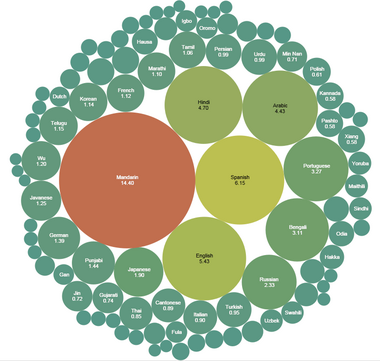Linguistic demography
Topic: Social
 From HandWiki - Reading time: 2 min
From HandWiki - Reading time: 2 min
Linguistic demography is the statistical study of languages among all populations. Estimating the number of speakers of a given language is not straightforward, and various estimates may diverge considerably. This is first of all due to the question of defining "language" vs. "dialect". Identification of varieties as a single language or as distinct languages is often based on ethnic, cultural, or political considerations rather than mutual intelligibility. The second difficulty is multilingualism, complicating the definition of "native language". Finally, in many countries, insufficient census data add to the difficulties.
Demolinguistics is a branch of Sociology of language observing linguistic trends as affected by population distribution and redistribution and by the status of societies.
Most spoken languages
The following table compares the estimates of Comrie (1998) and Weber (1997)[1] (number of native speakers in millions). Also given are the estimates of SIL Ethnologue (2005). Comparing estimates that do not date to the same year is problematic due to the 1.14% per year growth of world population (with significant regional differences).
| Language | Comrie (1998) | Weber (1997) | SIL | |
|---|---|---|---|---|
| 1. | Mandarin Chinese | 836 | 1,100 | 1,205 (1999) |
| 2.-4. | Hindustani | 333 | 250 | 422 (2001)[2] |
| Spanish | 332 | 300 | 322 (1995) | |
| English | 322 | 300 | 309 (1984) | |
| 5.-6. | Arabic | 186 | 200 | 323 (2008) |
| Bengali | 189 | 185 | 171 (1994) | |
| 7.-8. | Russian | 170 | 160 | 145 (2000) |
| Portuguese | 170 | 160 | 178 (1995) | |
| 9. | Japanese | 125 | 125 | 122 (1985) |
| 10. | German | 100 | 100 | 95.4 (1994) |
This table shows that for the world's largest languages, it is impossible to give an estimate of the number of native speakers with a certainty better than maybe 10% or 20% or so.
See also
- List of languages by number of native speakers
- List of languages by total number of speakers
- Abstand and ausbau languages
- Autonomous language
- Language geography
- Languages in censuses
Case studies:
- Language demographics of Quebec
- Language Spoken at Home (U.S. Census)
Notes
- ↑ Bernard Comrie, Encarta Encyclopedia (1998); George Weber “Top Languages: The World’s 10 Most Influential Languages” in Language Today (Vol. 2, Dec 1997)"Most Widely Spoken Languages". Archived from the original on 2011-09-27. https://web.archive.org/web/20110927062910/http://www2.ignatius.edu/faculty/turner/languages.htm. Retrieved 2011-09-28.
- ↑ "ethnic population"; SIL divides what is considered "Hindi" by other sources into numerous sub-languages. SIL's "Hindi" is Kharboli only.
Literature
- Johanna Nichols, Linguistic Diversity in Space and Time, University of Chicago Press (1992), ISBN:978-0-226-58056-2.
- David I. Kertzer and Dominique Arel (eds.), Census and Indentiry : The Politics of Race, Ethnicity, and Language in National Censuses, ISBN:978-0-521-80823-1.
- Jacques Pohl, Demolinguistics and Language Problems (1972).
- H. Kloss, G. McConnell (eds.), Linguistic Composition of the Nations of the World vol. 2, North America, Quebec (1974–1984).
External links
- CIA - The World Factbook
- M.Turner compares five language surveys - first language vs total speakers, degree of influence, etc. Plus graphs and charts.
- Top 100 languages
- Ethnologue
- Unicode.org Top Languages by GDP Graphs
 |
 KSF
KSF
